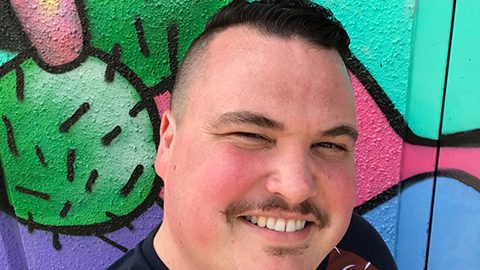
Drew Wilson (Master of Fine Arts, 2015) has a passion for art education. Before attending Columbus College of Art & Design, Wilson taught elementary school for five years via Teach for America.
After graduating from CCAD with a master’s degree, Wilson relocated to the San Francisco Bay Area, where he began working for Aspire Public Schools, a group of community-based public charter schools. He founded the art program at Aspire Richmond Technology Academy in Richmond, California, in 2016 and now teaches 350 students—from transitional kindergarteners to fifth-graders. It’s a diverse student population representing primarily Latinx students, with a sizeable portion of African American, Asian, and Pacific Islander students. That student body is represented in the curriculum Wilson has created, which encourages students to learn about artists from around the globe and find parallels in their lives.
It has been really inspiring to see growth made in all my students’ art making over the past three years,” Wilson said. “Many did not have an art teacher in their prior years of schooling, so I ground my practice in skill building around the elements of art and in socioemotional learning, which has given a strong foundation for students to succeed in learning new mediums and to use art as an emotional release and to express their point of view.”
How did graduate studies at CCAD influence your approach to art education?
My time at CCAD was grounding for me personally and as an art educator. I had the freedom to be project based and to deeply unpack my own identity as a queer artist and then weave in relevant art theory and explore new media and technology I was exposed to by faculty and my peers. Being surrounded in the studios by talented mentors and peers in so many different media is a huge benefit of CCAD’s master’s program. I was not confined to working only with other artists that create in a similar fashion to mine. The environment really becomes one of cross-pollination and collaboration, which allowed me to find the best media to express my ideas and make the most impact with each project I created.
After studying at CCAD, I have the tools to succeed as an artist and art educator. I am more versed in art theory and, specifically, in art based on identity due to courses taught by professors such as Tamara Mann and John Fergus Jean, and I am able to engage others in both my students’ and my personal artwork with the tech tools learned in Digital Culture with (now-Animation Chair) Charlotte Belland.
What is your biggest takeaway from your time at CCAD?
I am able to plan culturally responsive lessons that offer new perspectives to my students, as well as lessons that honor their diverse identities as we create beautiful art and learn various media. In our current political climate, where issues of race, gender, and sexuality are being kept in the margins, I am applying all I have learned at CCAD to give my students a tangible way to express their own brave voices for change.
What distinguishes the curriculum you’ve developed at Richmond Technology Academy?
As I have freedom to choose how I teach art skills to my students, I attended the National Art Education Association conference to learn more about curriculum building. I found that many art teachers are afraid to expose their students to modern and contemporary art, art from people of color, and, instead, are sticking to teaching the European masters. I am most proud of the culturally responsive curriculum I have developed around studying artists of color from around the world, artists who share similar life experiences with my students and that they can relate to.
Can you give examples of which artists students are studying, and how that’s expressed in the classroom?
Some of the artists my students have studied over the past couple years are Kehinde Wiley, Derrick Adams, Alfredo Arreguin, Frida Kahlo, Rufino Tamayo, Njideka Akunyili Crosby, Alejandro Canales, Gina Pellón, Fernando Llort, Favianna Rodriguez, Enrique Chagoya, Beatriz González, Romero Britto, Louie Cordero, and Mickalene Thomas. We focus on the themes of immigration, racism, equity, gender, and identity. I pair each particular artist with a skill I am working on with my students at their age-appropriate level, such as drawing various types of line, and then build a project around the skill and artist as our inspiration.
What do you hope to accomplish with Richmond Technology Academy’s art curriculum?
The art program I have fostered at Richmond Technology Academy celebrates diversity and inclusion of all cultures and is teaching our student artists to look at artwork as a way to share their feelings, beliefs, and identities. My students are engaged in art making and are celebrated and validated for just being themselves because they see artists who look like them, who journey through life the same way, and who believe what they believe. My goal in pursuing and creating this curriculum is that the art world will continue to be more diverse and that more children of color will love art, create art, express themselves with art, and pursue careers in the arts.
Learn more about the Master of Fine Arts program at CCAD or apply here.
